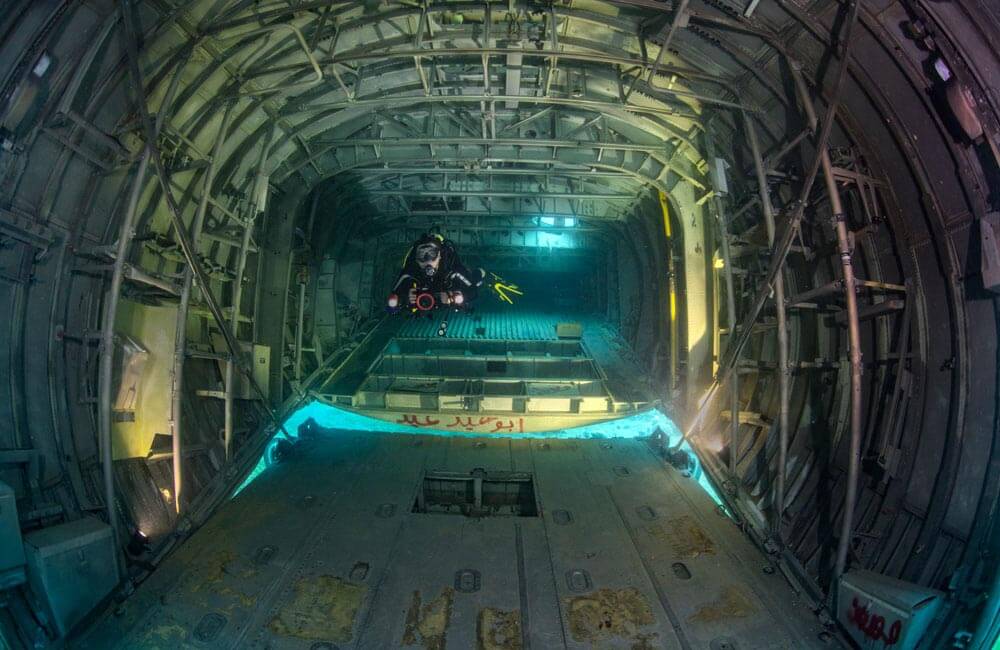
DIVE got to enjoy some of the first scuba dives on the wreck of the C130 Hercules transport aircraft, recently sunk just off the coast of Aqaba, Jordan
Words by Mark 'Crowley' Russell– Photos by Torbjorn Gylleus, DYK Magazine
On 16 November, with press and politicians and a brass band in attendance, a C-130 Hercules transport aircraft was sunk as an artificial wreck for scuba diving off the shores of Aqaba, Jordan.
The new dive site forms part of a project spearheaded by King Abdullah II himself, a drive to promote tourism to a country which has escaped relatively unscathed in the aftermath of an overall decline in visitors to the Red Sea, of which Egypt constitutes the vast majority.
The Hercules has been sunk in a very easily accessible location, not far from the wreck of the Cedar Pride, and only a few metres from the M42 ‘Duster’ anti-aircraft vehicle, more commonly known as ‘the Tank’
With an average maximum depth of around 16m and a flat bottom, the Hercules is upright and almost level, with a length of 30m and a wingspan of around 40m. The site is prone to only the lightest of currents, and descent onto the wreck is aided by the excellent Red Sea visibility, meaning it will almost always be visible from the surface.
Related articles:
- Aqaba’s underwater military museum
- Green Fins launched in Aqaba, Jordan
- An introduction to the wreck dives of Aqaba
- Jordan reopens its borders to tourism
Aircraft wrecks always have a slightly eerie feel about them, even if – as is the case with the C130 Hercules – they were deliberately sunk as artificial reefs. Although nobody would argue that ships belong under the water anymore so than aircraft, ships are at least sunk within their natural habitat, whereas the nose cone of an aeroplane looming above you lends an especially unnatural feel for the dive.
Hovering outside the cockpit at 12m is a particularly strange sensation – it seems so very small when you get up-close and personal, whereas back on land it would be several metres above your head. Several divers took the opportunity to straddle the nose cone which – while very strongly not recommended for preservation of the aircraft – gives some idea as to the strange warping of perspective as you start the dive peering into the cockpit windows.
Some darkly-humoured soul has taken the liberty of dressing a skeleton in a flight suit and helmet and strapping it into the pilot’s seat, a comical sight rather than in any way frightening, although inexperienced divers night-diving the plane may come to disagree.

Despite the small impression of the nose cone and cockpit, the Hercules is obviously a very large aircraft. The fuselage is taller than it is wide, and although the engines and propellers have been removed from the ‘plane to sterilise it prior to sinking, the long wing-span and empty engine cowlings do lend a striking impression of the power of the aircraft in service.
It would have been nice if there had been a way to re-engineer the propellers back into position, however, it would seem they have been re-purposed and, while purists may bemoan their absence, the preservation of the coral reef without the addition of petrochemicals is clearly more important.
Swimming over the fuselage at around 10m towards the rear of the aircraft, the monstrous tail looms large over the diver. Whereas the front of the Hercules may seem disproportionately small, the tail fin rises to around 5m under the surface and its proportions are not lost on the visiting diver.
Although the wreck is mostly level, the removal of the engines and the nose cone’s electronics has left the Hercules slightly tail heavy, with the nose gear raised slightly off the bottom. This almost gives the impression of an aircraft just about to take off, although the effect is lessened by virtue of the fact it’s underwater.
Practically speaking, it means that the tailgate, which was opened to provide an entrance to the loading bay, has been closed by the weight of the Hercules. However, penetration of the wreck is still straightforward. The doors of the aircraft have been removed, providing easy access to the cavernous interior, approximately 12m long and 3m wide and well-lit, thanks to the open doors and large array of cockpit windows.
The flight deck is also accessible, both from the interior and through the cockpit windows, allowing for plenty of photo opportunities with the skeletal captain, and the basic controls and steering columns remain in place – and will hopefully remain so, although souvenir hunters will no doubt already be planning their unnecessary retrieval.

That Aqaba’s C130 Hercules wreck has been made so accessible is, of course, deliberate and, as such, is not likely to attract the serious, dangerous wreck-penetrating techies, but that was never the intention. It’s a fun-for-all-the-family excursion which divers of all experience levels can enjoy, while their non-diving partners can snorkel above them. There’s plenty to see of the aircraft itself, and divers who wish to make more of the experience can visit the tank, or explore the coral and seagrass of the surrounding area which – thanks to the mild current – will no doubt aid the development of coral around the structure of the wreck itself.
In terms of Aqaba as a destination, veterans of Egyptian Red Sea diving will naturally find similarities between the locations. The Gulf of Aqaba is very narrow at its northern reaches, and the hotels of Taba are easily visible across the water, as is the Israeli city of Eilat. The sandstone mountains provide a familiar backdrop but – geologically speaking – they are all part of the same landmass, divided by the East Africa Rift that runs along the bottom of the Aqaba Gulf and the Red Sea proper.
Although it is tempting to equate the two countries with their similar landscapes and language, it’s no different than crossing the border between European countries and remarking on their inevitable similarities. Red Sea divers who are currently unwilling to visit Egypt due to a perceived lack of safety or the continuing refusal of the British FCO to approve flights to Sharm El Sheikh will find Aqaba a pleasing alternative. Although the reefs may lack the grandeur of the likes of Tiran and Ras Mohammed, they are nevertheless very beautiful and make for relaxed, easy, colourful recreational diving, and the wreck of the Cedar Pride is an outstanding highlight for visitors. Steep-sided drop-offs and wrecks such as the Taiyong and Al Shorouk provide for technical divers.
There is much more to Aqaba than an ‘alternative’ to Egypt. It is a destination in its own right and has much to offer its visitors. Aqaba is a bustling city with an outstanding waterfront and welcoming atmosphere, very cosmopolitan and culturally liberal. Wadi Rum, a desert valley rich in history and now popular as an eco-tourist destination run by the Bedouin who occupy the region, is well worth a day-trip, or as an experience camping and dining under the stars. Several luxury resorts have developed in the wadi.
Petra – a UNESCO World Heritage site and one of the ‘New Seven Wonders of the World’ – is a must-see for any visitor to Aqaba, an outstanding tour through the gorges of one of the world’s most ancient man-made waterways and the majestic tombs carved into the sandstone rock face. The entire site can take several days to explore, but a day-trip from the hotel is well worth the effort.

There are – currently – no direct flights to Aqaba from the UK, however, a flight to Amman from London by Royal Jordanian takes around 5 hours and arrives late in the evening, with the early morning connection to Aqaba taking just over 45 minutes, or the bus journey just over 4 hours. In its new drive for tourism, the government is looking at the implementation of charter flights which will undoubtedly be welcome, however, at present, indirect flights are the only option.
Our hosts for the diving were Sindbad Dive Club at the Berenice Beach Club, a large resort with a well-appointed dive centre, professional crew and excellent boats. Sindbad has its own personal jetty which means a very short ride to most of the dive sites, whereas other dive centres leave from the Royal Yacht Club, adding up to an hour to the boat ride. Sinai Divers, one of the longest-established Red Sea operations has a base in Aqaba at the Tala Bay Movenpick resort and also comes highly recommended. The other dive centres participating in the tour were Deep Blue and Sea Guard Diving.
For more information about diving Aqaba and things to do when you’re there, check out our Aqaba Destinations page.
With thanks to Torbjorn Gylleus and Dom Lee Zax of DYK Magazine for the excellent photographs of the wreck. Check out Scandinavia’s biggest dive magazine at DYK – The Scandinavian Dive Site


